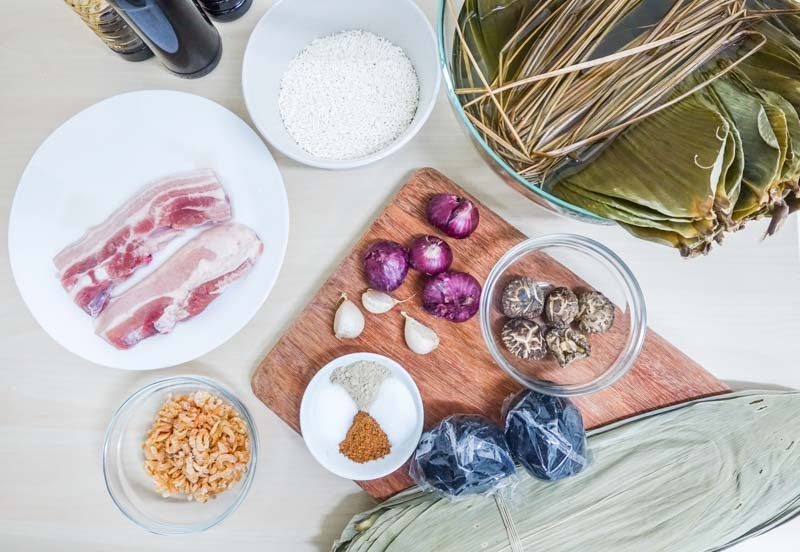Bak Zhang, otherwise known as 粽子, is widely enjoyed during Dragon Boat Festival (端午节). When I expressed interest in making them to my mum, grandmother, and a few others, their responses were synonymous: “Are you sure? You’ll have to put in a lot of hard work to make them.” “Oohh, for a first-timer, folding the bamboo leaves will be a tough one to deal with”.
Relentless, I went ahead to tread into uncharted waters for this post.

While there are several versions of its origin, the death of poet and minister Qu Yuan seems to be the most popular story that is being passed down from generations to generations. Check out the folktale story as to why the Chinese eat sticky rice dumplings to commemorate this festival.
Here’s a bak zhang recipe you could try your hands on making to carry on this tradition.
Honestly, the prep work is a bit of a nuisance, but once you get past it, you’ll be in the zone and wrapping bak zhang like a pro.
Ingredients
- One bunch of dried bamboo leaves (sold in a packet of four at your local supermarket)
- 2 cups of glutinous rice
- 500g pork belly
- 5 dried Chinese mushrooms
- 3 salted egg yolks (cut into halves)
- 4 shallots
- 3 garlic gloves
- ½ cup dried shrimps
- 10 tbsp cooking oil

For marinating the pork belly:
- 1 tbsp sugar
- 1 tsp salt
- 1 tbsp white pepper (adjust accordingly your preference of spiciness)
- 2 tsp light soy sauce
- 2 tsp dark soy sauce
- 2 tsp sesame oil
- Optional: 1½ tsp five-spice powder (五香粉)*
*If you’re using five-spice powder then skip on using salt and change light soy sauce to just one teaspoon.
Recipe preparation
Preparation + cooking time: Up to 24 hours (depending on soaking of bamboo leaves and meat marination)
Makes 6 to 8
Step 1: Wash and soak dried bamboo leaves and strings in a pot/pail of water, making sure it is fully submerged in water. I left mine to soak overnight, if you want it to be more pliable for folding, you can also boil it in water for an hour.
Step 2: In separate bowls, soak glutinous rice with just enough water to cover the top, soak mushrooms and dried shrimps for about an hour.
Step 3: Coat pork belly with a generous layer of salt and rinse off with water, then coat it with sugar and leave it for about 10 minutes.
Step 4: Slice it into strips of desired thickness, then add in pepper, salt or five-spice powder, along with light and dark soy sauce to marinate for about an hour. If you want your meat to look darker in colour, then add more dark soy sauce. For a more intense flavour, marinate it overnight in the fridge.
*Step one to four can be done simultaneously over an hour
Step 5: Chop shallots into thin slices, mince garlic, slice mushrooms into strips, and cut up the salted egg yolks into halves.

Step 6: Fry the thinly sliced shallots in a wok with 10 tablespoons of oil, allowing them to turn golden brown. Then scoop up and let cool. Yes, it’s not a typo, these 10 tablespoons of oil will be used to fry up the other ingredients too.
Step 7: Toss garlic and fry in the remaining oil until slightly golden brown, then stir fry shrimp until lightly crisp, add in mushrooms and pork belly. Prepare ½ cup of water and slowly adding it in if it becomes too dry. Plate when pork belly is thoroughly cooked.
Step 8: Drain glutinous rice and stir fry in the same wok, add half a portion of the fried shallots, season with a teaspoon of sesame oil, light and dark soy sauce, half a teaspoon of salt, a dash of pepper. Stir fry on low fire for about five minutes, then plate it.
Wrapping the bak zhang ingredients
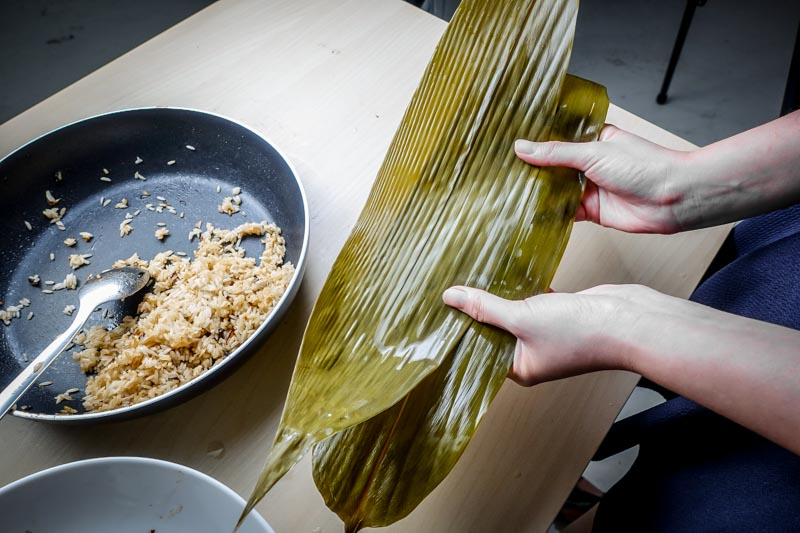
Find two of the largest, most flawless bamboo leaves in the batch to work with, they should not be broken, torn or have holes in them. The smooth side of the leaves should be facing upwards towards you, overlap them with the pointy sides at both ends.

Place thumbs in the middle of the leaves and fold them upwards into a cone shape.
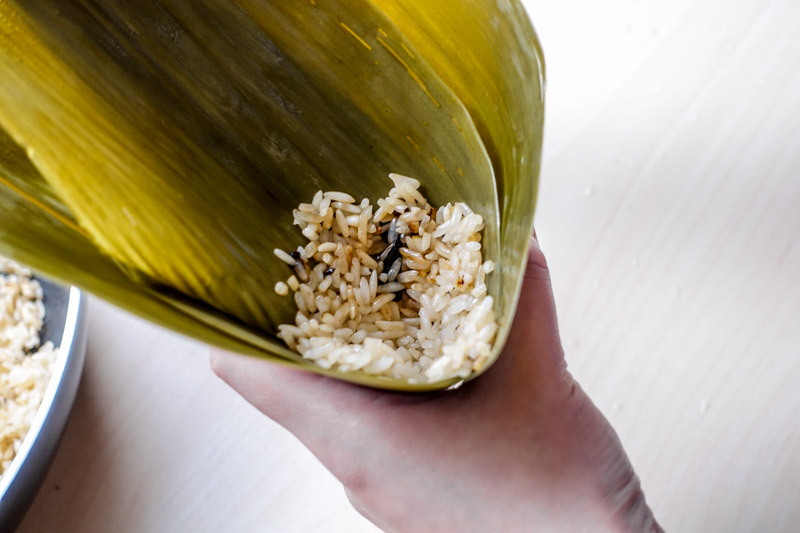
Fill leaf cone with one tablespoon of glutinous rice, making a small crater in the middle to hold the ingredients. Make sure your hand-holding onto the cone is relaxed, too.

Add a spoonful of pork belly, mushrooms, shrimps, and salted egg yolk into the cone.


Cover the ingredients up with rice. It is not necessary to squeeze down the rice as it will expand and take shape when cooked. However, if you want a bigger bak zhang then go ahead and pat it down and fill it up with more rice.

While most just fold the cone down into the remaining leaves, I like to cheat a little and further secure them by folding in the sides to hold in the rice. This helps to create the last corner of the triangle.

Here’s the slightly tricky part, flip the cone down and fold up the remaining leaves.

Wrap the leaves with bamboo strings twice over the bak chang, secure it with a double knot. I was slightly kiasu, tying rounds after rounds to make sure they stay tightly wrapped.

It doesn’t matter if it looks small in size now, these bak zhang will expand slightly once they have been cooked.
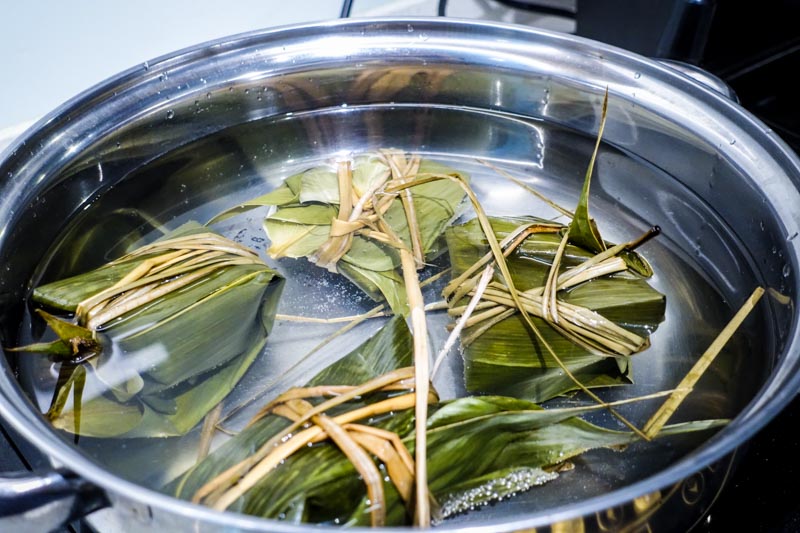
Submerge bak zhang entirely in water and bring to boil for an hour and a half, adding half a teaspoon of salt to the water for taste.
Time to unwrap and enjoy your bak zhang
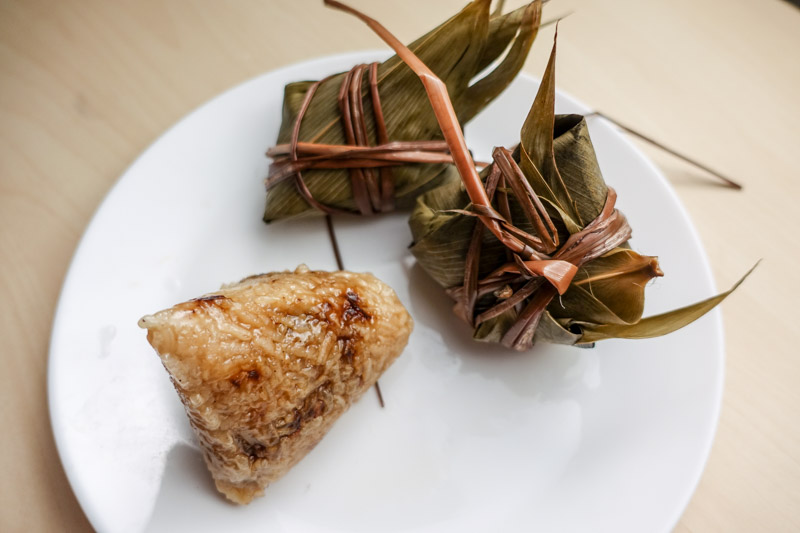

You can finally enjoy the labour of your hard work after tending to these bak zhangs for the entire day.

Scurry on now to impress your family, soon you’d be hearing praises ringing in your ears. But beware, they might ask you to make bak zhang every year from now on.
If you think that your or your great (great-great-great) grandmother’s recipe is better than this, share it with us.
Other articles you might like:
3-ingredient stay-home recipe: Insanely easy Crème Brûlée
Kitchen essentials explained: 7 food containers to get yourself organised

